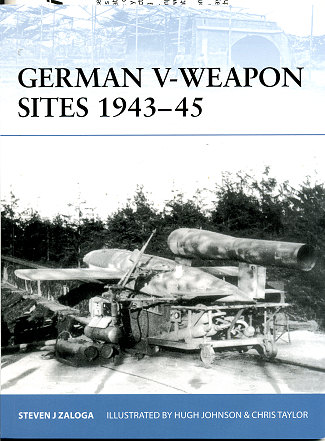 #72 in
Osprey's continuing "Fortress" series covers the German V-weapon sites as
created to use the V-1/2/3/4 weapons. First thing one notices is that Osprey has
redesigned the cover of their books with a faded landscape image from inside the
book atop the normal cover illustration/photo. Nicely done.
#72 in
Osprey's continuing "Fortress" series covers the German V-weapon sites as
created to use the V-1/2/3/4 weapons. First thing one notices is that Osprey has
redesigned the cover of their books with a faded landscape image from inside the
book atop the normal cover illustration/photo. Nicely done.
During WWII Germany expended considerable effort and funds on
what turned out to be dead end projects that did little for the war effort.
However, often times one never knows how things will work out unless they are
tried.
Those 'vengeance' weapons most known to readers are the V-1
cruise missile and V-2 ballistic missile. This book covers the extensive works
constructed to both build and operate these weapons. It also covers the rather
unknown V-3 long range cannon and V-4 artillery rocket. The latter two really
turned out to be less successful than hoped, though both were utilized in an
extremely minor role.
The majority of effort went into the V-1 and V-2. Both of
these required extensive launch and support mechanisms. This was particularly
true of the V-2 due to the need for liquid oxygen (LOX) for the propellant. In
fact, this lack of LOX production probably resulted in fewer actual launches as
there were missiles. Nearly 3,000 V-2s were launched during the war, over half
of them against Antwerp. Many of these launches were from mobile launchers as
fixed sites kept being discovered and bombed by the Allies.
The same sort of thing happened with V-1 sites, though not to
the extent of the V-2 in terms of moving the missile to mobile launch
capabilities. The V-1 launch facilities, though heavily bombed, seem to have
been easier to disguise and the result was tens of thousands of launches against
Allied targets right up until war's end.
Author Zaloga covers the development and operational use of
these weapons as well as the planning and construction of sites, some of which
were of gargantuan proportions. So huge were some of these works that they are
still extant to some degree, mostly because destruction of them would require a
massive undertaking regarding processing the rubble! The use of period images as
well as the superb illustrations of Johnson and Taylor really add to the value
of this book by showing how some of these massive constructs would have appeared
if left unbombed.
In all, an exemplary edition on one of the more interesting
aspects of the German military during WWII.
January 2008.
For more on the complete line of Osprey books,
visit www.ospreypublishing.com. In the US, it is
Osprey Direct at 44-02 23rd St, Suite 219, Long Island City, NY 11101., where you can
get a catalogue of available books.
If you would like your product reviewed fairly and quickly, please contact
me or see other details in the Note to
Contributors.
 #72 in
Osprey's continuing "Fortress" series covers the German V-weapon sites as
created to use the V-1/2/3/4 weapons. First thing one notices is that Osprey has
redesigned the cover of their books with a faded landscape image from inside the
book atop the normal cover illustration/photo. Nicely done.
#72 in
Osprey's continuing "Fortress" series covers the German V-weapon sites as
created to use the V-1/2/3/4 weapons. First thing one notices is that Osprey has
redesigned the cover of their books with a faded landscape image from inside the
book atop the normal cover illustration/photo. Nicely done.